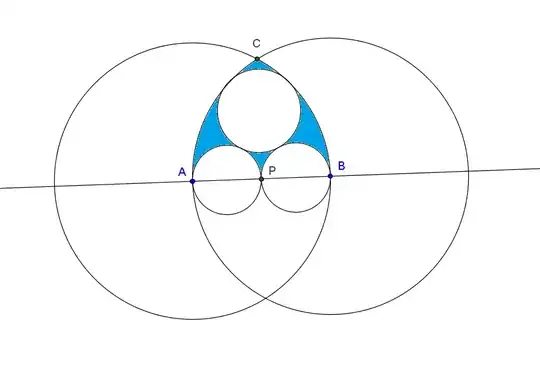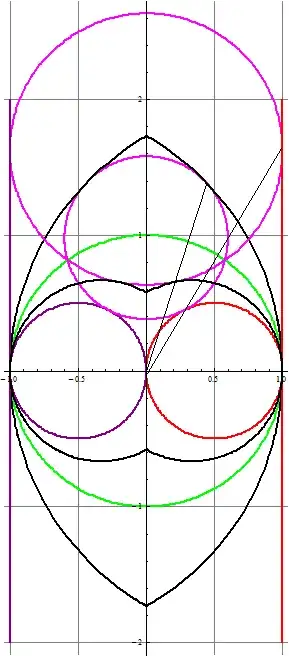I need to find an area of blue part of figure APBC. I draw line segments between B and C, between C and A, and got equilateral triangle. I'm stuck here. Please help. Thanks.

|AB| = a, P is midpoint of segment AB
As achille hui says in the coments, $$(1-r)^2 = |AF|^2 = \frac{1}{2^2} + |PF|^2 = \frac{1}{2^2} + |DF|^2 - \frac{1}{4^2} = \frac{1}{2^2} + \left(r + \frac14\right)^2 - \frac{1}{4^2}.$$ Solve for $r$ and you get $r=\dfrac{3}{10}.$
Since area of intersection between the two larger circles is $\dfrac{2\pi}{3}-\dfrac{\sqrt{3}}{2}$ (see here), shaded area is
\begin{align} &\dfrac{1}{2}\left(\dfrac{2\pi}{3}-\dfrac{\sqrt{3}}{2}\right)-\pi\left(\dfrac{1}{4}\right)^2-\pi\left(\dfrac{3}{10}\right)^2\\ \\ & = \dfrac{217 \pi }{1200}-\dfrac{\sqrt{3}}{4}\\ \end{align}
Notes
Derivation
Choose a new coordinate system such that $P$ is the origin $(0,0)$ and the two points $A, B$ are located at $(-1,0)$ and $(1,0)$ respectively.
Perform an inversion of the plane at $P$ with respect to the unit circle $x^2+y^2 = 1$.
$$\mathbb{R}^2 \ni (x,y) \quad\mapsto\quad \left( \frac{x}{x^2 + y^2}, \frac{y}{x^2 + y^2} \right) \in \mathbb{R}^2$$
Let $Z_0 = (0,h_0)$ be the center of $c_0$, we have $$XZ_0 = 1 + \frac23 = \frac53\quad\implies\quad h_0 = \sqrt{\left(\frac53\right)^2 - \left(\frac13\right)^2} = \frac{\sqrt{24}}{3}$$
This implies $c_0$ intersect the $y$-axis at $$ \left(0, \frac{\sqrt{24}}{3}-1\right) \quad\text{ and }\quad \left(0,\frac{\sqrt{24}}{3}+1\right) $$ and hence the original inscribed circle intersect $y$-axis at $$ \left(0,\frac{1}{\frac{\sqrt{24}}{3}-1}\right) \quad\text{ and }\quad \left(0,\frac{1}{\frac{\sqrt{24}}{3}+1}\right) $$ As a result, the radius of the inscribed circle is given by $$ \frac{r_0}{AB} = \frac14\left(\frac{1}{\frac{\sqrt{24}}{3}-1} - \frac{1}{\frac{\sqrt{24}}{3}+1}\right) = \frac{3}{10} $$ matching what I described in comment.
Bonus
This approach using inversion is slightly longer than one working with the circles directly.
However, it leads to an interesting extension!
Since $\ell_A$ and $\ell_B$ are parallel, we can stack on top of $c_0$ an infinite sequences of circles $c_1, c_2, \ldots$ of radius $1$. The $n^{th}$ circle will be centered at $$Z_n = (0,h_n) = \left(0, \frac{\sqrt{24}}{3} + 2n\right)$$
If we invert these circle back, we will obtain a sequence of circles inserted between the inscribed circle and the two small circles. The radius of the $n^{th}$ circle will be given by the formula
$$\frac{r_n}{AB} = \frac14 \left(\frac{1}{\frac{\sqrt{24}}{3}+2n-1} - \frac{1}{\frac{\sqrt{24}}{3}+2n+1}\right) = \frac{3}{10 + 16\sqrt{6}n+24n^2} $$ This is the sequence of circles mentioned in Martin's extended version of this problem.
 Some visibility for the interesting topic, to visualize them for further on..
– Narasimham
Nov 28 '14 at 19:44
Some visibility for the interesting topic, to visualize them for further on..
– Narasimham
Nov 28 '14 at 19:44
I believe we can use Descartes Circle Theorem. We can identify 4 circles:
Unfortunately, these 4 circles are not mutually tangent since the circle with diameter $\overline{AP}$ is not tangent to the circle $O_A$ with center at $A$.
The general Apollonius problem involves finding a circle tangent to 3 other circles (regardless of mutual tangency).
One, rather boring, solution is to solve 3 quadratic equations. Let $x,y,r$ be the center and radius of the unknown circle.
$$ (x-x_k)^2 + (y-y_k)^2 = (r \pm r_k)^2$$
where $k = 1,2,3$. Using the diagram, we put in the centers and radii.
$$ x^2 + y^2 = (r \pm 4)^2$$ $$ (x-1)^2 + y^2 = (r \pm 1)^2$$ $$ (x-3)^2 + y^2 = (r \pm 1)^2$$
In order to get the signs right, our circle is inside the first circle and outside the other two.
$$ x^2 + y^2 = (r - 4)^2$$ $$ (x-1)^2 + y^2 = (r + 1)^2$$ $$ (x-3)^2 + y^2 = (r + 1)^2$$
The fact that $x = 2$ should have been clear from the diagram. Writing the system again:
$$ 2^2 + y^2 = (r - 4)^2$$ $$ 1^2 + y^2 = (r + 1)^2$$
We can subtract the first and second equations, it is possible to solve the linear equation for $r$:
$$ 3 = 2^2 - 1^2 = (r-4)^2 - (r+1)^2 = (r^2-8r + 16) - (r^2 + 2r + 1) = -10r + 15$$
The answer is $r = \tfrac{6}{5}$. If we rescale so the radius with center $0$ is the unit circle, we get $\boxed{r=\tfrac{3}{10}}$
A more interesting solution would exploit the symmetry of the problem or use inversion somehow.
Let $|AB| = a$, $|BC|=a$, $|CA|=a.$ By Pythag we know $|PC|=\sqrt{a^2 - (\frac{a}{2})^2}$ and therefore the area of the equilateral triangle $ABC$ is $\frac{a\left(\sqrt{a^2 - (\frac{a}{2})^2}\right)}{2}$. Now if $ABC$ is an equilateral triangle then the angle between $AB$ and $BC$ is $\pi/3$.
So we work out the area between the edge of the circle and the triangle $ABC$, there are 2 of these but they are equal. To do this we find the area of one of the segments of the circle $AB$, $BC$ which is $\frac{\pi a^2}{6}$ and then minus the area of the equilateral triangle, so we get:
\begin{equation} X=\frac{\pi a^2}{6}-\frac{a\left(\sqrt{a^2 -(\frac{a}{2})^2}\right)}{2} \end{equation} So the total area in the $ABC$ area (the blue and the white circles combined) is: \begin{equation} \begin{aligned} Y=& \frac{a\left(\sqrt{a^2 - (\frac{a}{2})^2}\right)}{2} +2X \\ =& \frac{\pi a^2}{3} - \frac{a\left(\sqrt{a^2 -(\frac{a}{2})^2}\right)}{2} \end{aligned} \end{equation}
Now we have that area we just need to minus the area of the white circles inside it. The two semi-cicles on the line $AB$ are of same size and therefore we can just minus the area of the full circle equal to $\frac{\pi a^2}{16}$. Now we just need the area of the full circle at the top, call it $Z$. Then the blue area is equal to $Y - \frac{\pi a^2}{16} - Z$. Unfortunately at the moment I can't work out the area $Z$ but I thought i'd still share the rest of this answer and hopefully you can get it.
i think this "answer" seems too good to be true. i would like someone to check this out.
let me take $AB = 4.$ claim: radius of the circle(midcircle) touching the smaller circles is $\frac{6}{5}.$
proof of the claim. let $C$ be the center of the said circle. let $AC$ meet the circle of radius $4$ at $D.$ join $C$ to the center $E$ of the circle with diameter $AP.$ let $CD,$ radius of the midcircle be $x.$
look at the triangle $AEC.$ we have $AE = 1, EC = 1 + x$ and $AC = 4 - x.$ so by cosine rule, $\cos A = \frac{1^2 + (4-x)^2 - (1+x)^2}{2*1*(4-x)}.$
we can also compute $\cos A$ form the right triangle $APE,$ which give $\cos A = \frac{2}{4-x}.$
equating these two, i find $x = \frac{6}{5}$, or, $ \frac x {AB} = \frac 3{10} $
If you know the radius of the circles it would be really simple.
You could just find the area of the intersection and subtract the area of the circle with diameter AP and the are of the circle between.
OK, I shall re-do this.
Left middle circle equation:$ (x-a/4)^2+y^2= (a/4)^2 $ (1*)
Top circle sitting on middle circles: $ x^2 +(y-k)^2 = r^2$ (2*)
Consider right angled triangle connecting circle centers and center of given area:
$ \, k^2 + (a/4)^2 = (r +a/4) ^2 $ simplifying to:
$ k^2 = r (r+ a/2) $ (3*)
Equation of circle centered at B:
$ (x-a/2)^2+y^2= a^2 $ (4*)
Eliminate $ (x^2+y^2) $ between (2*) and (4*) using (3*) and simplify, to result in the secant line of circle segment:
$ - x + 2\, y\, u = v $ where $ u= \sqrt{(r/a) ( r/a + 1/2)}, v = ( 3 a + 2 r)/4 $ (5*)
We can find intersection points $(x,y)$ between the top circle and circle centered at B by solving (4*) and (5*) through which this secant line can be made to pass. Only the two y co-ordinates are given here after simplification as they are sufficient to find $r$. Also $r/a$ is abbreviated as $r$, $ a=1.$
$$ \frac{y}{a} = \frac {(5+2 r) \sqrt {2 r ( 1 + 2 r)} \pm \sqrt{3 ( 1+2\, r) ( 10\, r -3)}} {4 ( 1 + 2 r + 4 r^2)} $$
The secant becomes a tangent when two roots coincide,i.e., when quantity under second radical sign vanishes to give condition for fixing radius of the top circle at point of tangency.
$$ r =\frac{ 3 a}{10} , k/a \approx 0.489898 $$
Similarly for x. We can also find the point of tangency, $( x/a, y/a) $ by plugging in $ r = 3 a/10$. Blue area is obtained by subtraction of the area of circles.
Anyway, it's a simple beautiful problem.
The hardest part of the problem is figuring out what $r$ is. You can determine that using following relation:
$$(1-r)^2 = |AF|^2 = \frac{1}{2^2} + |PF|^2 = \frac{1}{2^2} + |DF|^2 - \frac{1}{4^2} = \frac{1}{2^2} + \left(r + \frac14\right)^2 - \frac{1}{4^2} $$
– achille hui Nov 14 '14 at 23:28Unfortunately, these 4 circles are not mutually tangent since the circle with diameter $\overline{AP}$ is not tangent to the circle $O_A$ with center at $A$.
– cactus314 Nov 27 '14 at 13:36